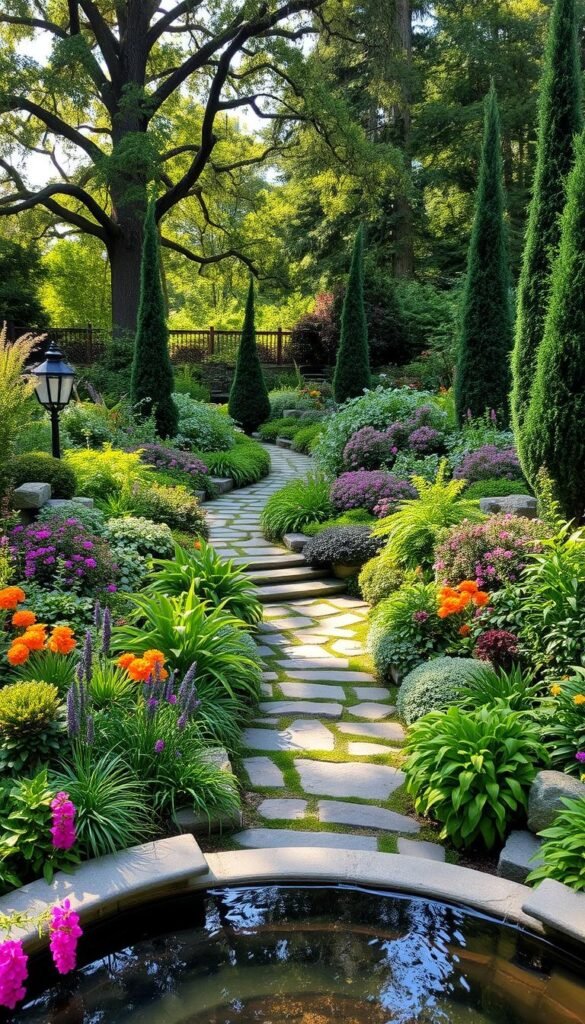Imagine stepping outside to a vibrant outdoor space that delights your senses whether it’s blooming spring or frosty December. Thoughtful plant selection and layout turn ordinary yards into living art that evolves with nature’s calendar. This approach works for patio containers, urban plots, or sprawling landscapes – size doesn’t limit beauty.
By working with seasonal rhythms instead of against them, you’ll enjoy fresh colors, textures, and harvests all year long. A well-structured four-season layout reduces empty gaps where nothing grows while supporting birds and pollinators even in colder months. Evergreen shrubs paired with winter berries create cozy habitats while keeping your view lively.
The secret? Plan for overlapping bloom times and plants with multiple features – like ornamental grasses that sway in autumn winds and catch snowflakes in winter. You’ll spend less time replanting and more time savoring your personal oasis through every weather change.
Ready to transform your space? Let’s explore how simple tweaks create nonstop charm while making your green haven easier to maintain. From strategic evergreen placement to clever container rotations, these ideas work immediately – no professional help required.
Understanding the Benefits of a Year-Round Garden
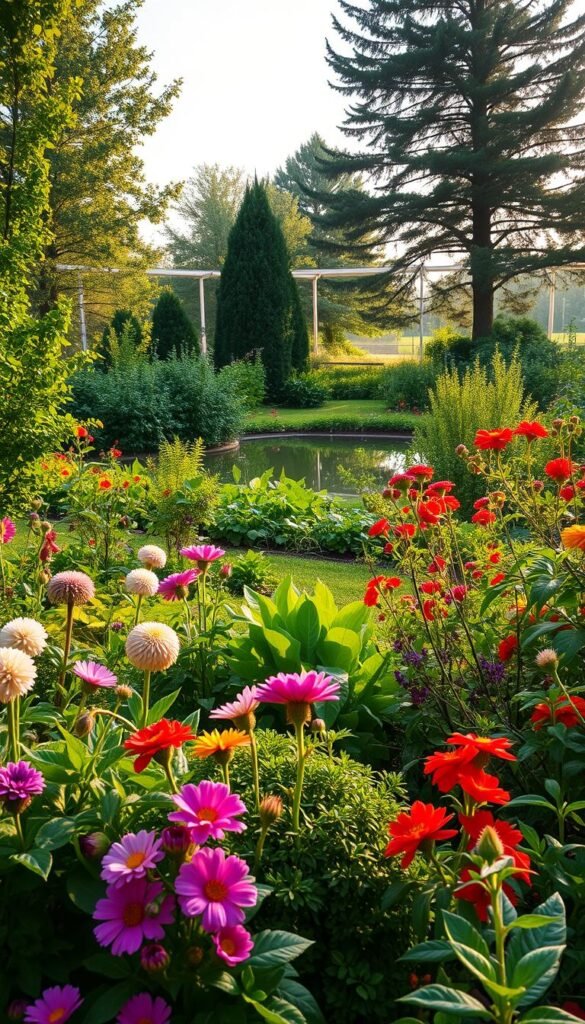
Beyond seasonal blooms, a thoughtfully planned outdoor space offers rewards that ripple through your home and local ecosystem. You’ll create habitats for butterflies, bees, and birds while enjoying fresh-picked flowers even when snow blankets the ground. This living network does more than look pretty—it strengthens biodiversity and gives you nature’s best features at arm’s reach.
Want to slash your grocery bill? Many edible plants thrive in cooler weather. Kale and rosemary often outlast summer crops, while winterberries add pops of crimson to gray landscapes. “A well-stocked plot becomes your personal farmers’ market,” says one urban gardener, noting how her December harvests rival July’s bounty.
The mental perks surprise many. Tending vibrant beds during shorter days combats seasonal blues, giving you reasons to bundle up and breathe crisp air. You’ll notice details missed in busier months—the way frost clings to sedum heads or cardinals dart between evergreen branches.
Best part? These advantages grow yearly. As shrubs mature and perennials spread, your effort decreases while beauty multiplies. You’re not just planting flowers—you’re cultivating a legacy that feeds body, mind, and soil through every season’s turn.
Exploring Seasonal Changes in Your Outdoor Space
Your outdoor space transforms like a living calendar, revealing new opportunities with each month. Start by sketching permanent fixtures—paths, patios, and mature trees—that shape your landscape’s backbone. These elements guide where seasonal magic happens.
Identifying Shifting Sunlight and Temperature Patterns
Notice how winter sun sits lower, casting longer shadows over summer’s brightest spots. A south-facing wall might bake tomatoes in July but shelter frost-sensitive camellias in January. Track these shifts monthly—your phone’s timelapse feature works wonders for visualizing light changes.
Microclimates emerge naturally. Low areas hold cold air, delaying spring blooms but extending fall color. “I plant hardy kale in my north-side dip—it thrives when other beds freeze,” shares a Zone 6 gardener. Use USDA zone maps as starting points, then refine based on your observations.
Recognizing Seasonal Foliage and Plant Behavior
Deciduous shrubs like hydrangeas become skeletal in winter, revealing evergreen neighbors. Pair them with red twig dogwood for fiery stems that pop against snow. Watch how perennials like sedum collapse after frost but leave seed heads for hungry chickadees.
Track which plants volunteer seedlings—a sign they’re thriving in your conditions. Swap struggling specimens with natives that match your space’s natural rhythm. Over time, you’ll curate a self-sustaining display that celebrates every season’s unique voice.
Multi-Season Garden Design: Planning for Year-Round Visual Interest
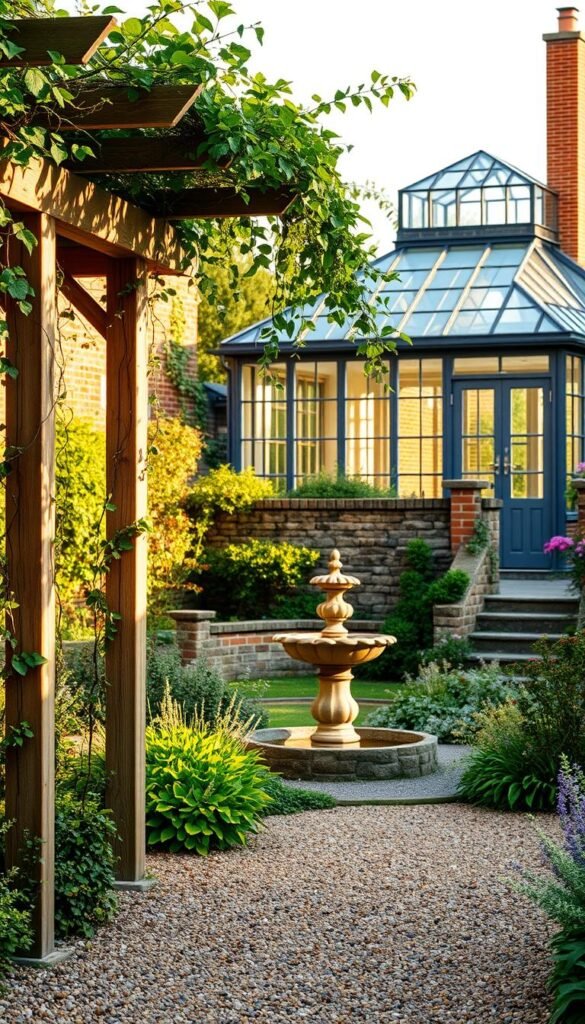
Your outdoor area’s magic lies in elements that stand strong through every weather shift. Sturdy frameworks like pergolas and stone walls do double duty – supporting climbing roses in summer while casting artistic shadows on snowdrifts come January.
Building with Timeless Features and Strategic Hues
Evergreen shrubs act as nature’s curtain rods, displaying seasonal blooms while keeping their lush greenery. Try pairing boxwood hedges with crimson-tipped heuchera plants – the contrast pops in any month. Stone pathways gain character when frost highlights their textures, becoming winter art pieces.
Smart material selection makes maintenance easier. Powder-coated steel arches withstand decades of weather while hosting different vines yearly. Local sandstone walls blend with regional landscapes and elevate your space through color consistency.
| Material | Summer Role | Winter Impact | Color Options |
|---|---|---|---|
| Weather-treated wood | Supports clematis | Showcases snow caps | Natural or stained |
| Corten steel | Modern backdrop | Rusty warm tones | Earth tones |
| Fieldstone | Herb garden border | Frosted textures | Regional hues |
Water features prove four-season worthiness when designed right. A small recirculating stream attracts dragonflies in August and becomes an ice sculpture gallery in colder months. Surround it with carex grass for movement that lasts through fall winds.
Remember: permanent elements should enhance your plantings, not compete. Choose neutral tones for structures so floral colors shine brighter. This balance keeps your space feeling alive even when annuals fade.
Building a Durable Planting Framework for All Seasons
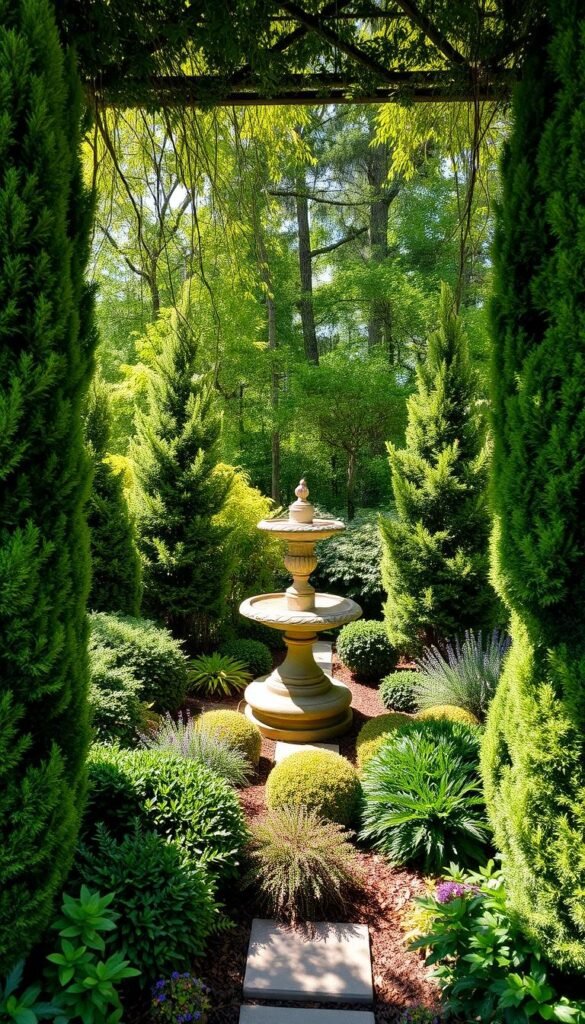
A garden’s true beauty lies in its backbone—plants that stand strong through every season. These permanent elements give your space shape and depth, even when summer blooms fade or autumn leaves drop. Start by choosing evergreen shrubs and ornamental trees that thrive in your region’s climate.
Anchoring Your Layout with Evergreens and Hardscaping
Boxwoods and dwarf conifers work like nature’s scaffolding. They keep beds looking full during winter while framing colorful annuals in warmer months. Place taller varieties behind flower displays—their rich green hues make red poppies or purple salvias pop.
Hardscaping should team up with your plants, not steal the show. Stone paths or weathered wood arbors add texture without overwhelming delicate foliage. A landscaper in Colorado notes: “My clients’ favorite spaces blend slate walkways with juniper shrubs—the combo looks sharp in July and under snow.”
| Plant | Key Features | Winter Role | Maintenance Tips |
|---|---|---|---|
| Holly | Glossy leaves, red berries | Food source for birds | Prune in early spring |
| Dwarf Pine | Compact growth | Windbreak for beds | Mulch root zone |
| Heavenly Bamboo | Color-changing foliage | Striking red stems | Water during droughts |
Test your soil before planting—evergreens often prefer slightly acidic conditions. Mix in compost if needed to help roots establish. Smart placement creates microclimates too; a holly hedge can shield tender roses from harsh winds.
This framework pays off year after year. Mature evergreens need less care than replanted annuals, giving you more time to enjoy your evolving oasis. Your garden becomes a living sculpture that withstands frost, heat, and everything between.
Implementing Strategic Plant Rotation
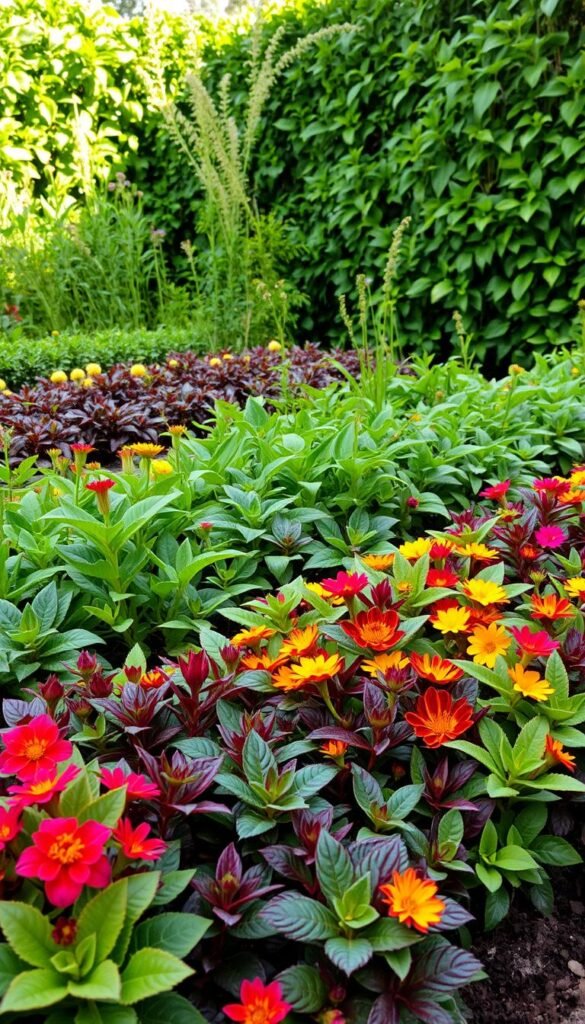
Keep your outdoor space lively through every season by mastering nature’s rhythm. Smart plant swaps maintain color and productivity without empty gaps. Timing matters most—learn when to pull fading blooms and introduce new stars.
Spring Bulbs Make Way for Summer Fireworks
As tulip leaves yellow and daffodils fade, heat-loving annuals take their place. Zinnias and marigolds thrive where spring bulbs once bloomed. For veggies, replace lettuce with tomato starters as soil warms. A seasonal care schedule ensures seamless handoffs between crops.
Autumn’s Arrival Demands Bold Choices
When summer blooms wilt under September sun, chrysanthemums and asters rise to the occasion. Ornamental kale adds texture through frosty mornings. “Rotate 2-3 weeks before first frost for established roots,” advises a Michigan grower. This gives fall plants time to shine before winter’s harshest days.
Create a rotation calendar tracking bloom times and harvest windows. Overlap plantings so new arrivals hit their stride as predecessors fade. With practice, you’ll develop an intuitive sense for nature’s transitions—and enjoy nonstop beauty in every corner.
Designing Layered and Textured Garden Beds
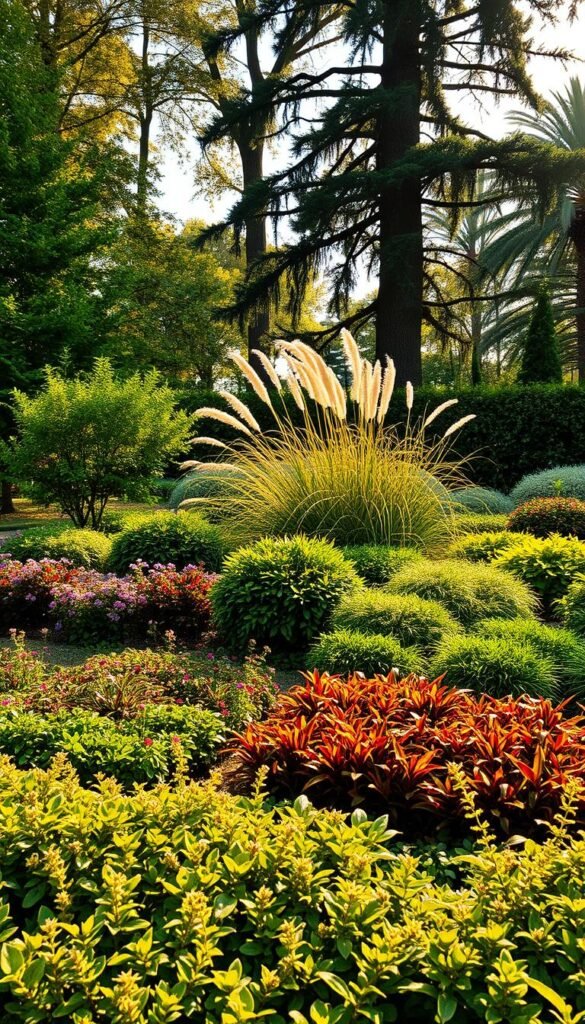
Transform flat beds into living tapestries that shift with the seasons. By stacking plants of varying heights and textures, you create depth that catches the eye from every angle. Think beyond rows—arrange specimens in clusters that rise and fall like natural landforms.
Utilizing Different Plant Heights and Foliage Types
Start with a central spire—maybe ornamental alliums or Joe-Pye weed. Surround them with mid-sized bloomers like coneflowers, then edge with creeping thyme. This 360° approach works wonders in raised bed gardens, where elevation highlights each layer.
Mix broad hosta leaves with feathery astilbes for contrast that lasts beyond bloom times. As one gardener notes: “Foliage carries the show when flowers take intermissions.” Tuck spring bulbs under daylilies—their fading leaves get hidden by emerging summer growth.
| Plant | Height | Bloom Time | Foliage Type |
|---|---|---|---|
| Allium | Tall (24-36″) | Late Spring | Strappy |
| Coneflower | Medium (18-24″) | Summer | Coarse |
| Creeping Thyme | Short (2-4″) | Early Summer | Fine |
| Hosta | Medium (12-18″) | N/A | Broad |
| Sedum | Medium (8-12″) | Fall | Succulent |
This structured approach solves common problems. Tall specimens create shade for heat-sensitive neighbors. Spiky seed heads add winter intrigue when frosted. You’ll craft habitats where ladybugs patrol and hummingbirds dart between levels.
Remember: success lies in planned imperfection. Let some plants self-seed between others. Allow shorter varieties to spill over edges. Your bed becomes an evolving masterpiece—always changing, always captivating.
Integrating Modular Elements and Weather-Resilient Features
Your outdoor area becomes a dynamic stage where flexibility meets function. Adaptable features let you respond to weather extremes while keeping your space productive and eye-catching. These solutions work whether you’re shielding delicate blooms or extending your harvest window.
Using Portable Planters and Moveable Structures
Wheeled containers become your secret weapon against shifting seasons. Roll citrus trees into sunny spots during summer, then pivot them toward sheltered walls when frost threatens. Lightweight grow bags let you rearrange herbs weekly to chase the sun’s changing path across your patio.
Retractable shade sails prove invaluable during heatwaves. Install them over seating areas or vegetable beds—simply adjust coverage as temperatures climb. One gardener notes: “My tomatoes thrived under 30% shade cloth when July temps hit triple digits.”
Incorporating Shade Cloths and Windbreaks
Protect tender plants without permanent installations. Temporary burlap screens block icy winds while letting sunlight through. For year-round protection, plant evergreen shrubs like juniper on your garden’s windward side—they’ll filter harsh gusts while adding winter texture.
These smart features help your plants thrive through seasonal challenges. You’ll spend less time battling weather and more enjoying your evolving outdoor haven. With movable elements, every corner becomes prime real estate regardless of what nature delivers next.

